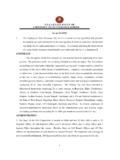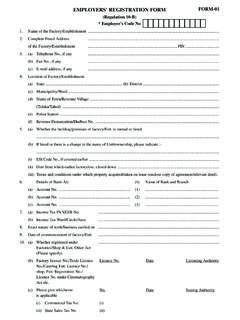Transcription of Index [www.esic.nic.in]
1 1. frequently . asked . QUESTIONS. ON. ESI SCHEME. This booklet is only for awareness purpose and can't be referred/ quoted as legal document Index Pages EMLOYER & EMPLOYEE RELATED 2-10. DEFINITIONS/KEY WORDS 11-18. 2. EMPLOYER & EMPLOYEE RELATED. 1. What is ESI Scheme? It is a comprehensive Social Security Scheme designed to accomplish the task of socially protecting the 'employees' in the organized sector against the events of sickness, maternity, disablement and death due to employment injury and to provide medical care to the insured employees and their families. 2. How does the scheme help the employees? The scheme provides full medical care to the employee registered under the scheme during the period of his incapacity for restoration of his health and working capacity. It provides financial assistance to compensate the loss of his/ her wages during the period of his abstention from work due to sickness, maternity and employment injury.
2 The scheme provides medical care to his/her family members also. 3. Who administers the ESI Scheme? The ESI Scheme is administered by a corporate body called the 'Employees' State Insurance Corporation' (ESIC), which has members representing Employers, Employees, the Central Government, State Government, Medical Profession and the Parliament. The Director General is the Chief Executive Officer of the Corporation and is also an ex-officio member of the Corporation. 4. What are the other bodies of the ESI Corporation? At the National level, the Standing Committee (a representative body of the Corporation). for administering the affairs of the Corporation, and the Medical Benefit Council, a specialized body that advises the Corporation on administration of Medical Benefit, are functioning. At the Regional Level, the Regional Boards and Local Committees have been constituted to review the functioning of the scheme and make suggestions for its improvement.
3 3. 5. How the Scheme is funded? The ESI scheme is a self financing scheme. The ESI funds are primarily built out of contribution from employers and employees payable monthly at a fixed percentage of wages paid. The State Governments also contribute1/8th share of the cost of Medical Benefit. 6. Implemented Area ESI Scheme is implemented in phases in different part of the country through Gazette notification after making the infrastructure available towards dispensation of medical as well as other benefits provided under the provisions of the Act to the prospective beneficiary. 7. What are the establishments that attract coverage under ESI? According to the notification issued by the appropriate Government (Central/State). concerned under Section 1(5) of the Act, the following establishments employing 10 or more persons attracts ESI coverage. (i) Shops (ii) Hotels or restaurants not having any manufacturing activity, but only engaged in 'sales'.
4 (iii) Cinemas including preview theatres;. (iv) Road Motor Transport Establishments;. (v) News paper establishments.(that is not covered as factory under (12));. (vi) Private Educational Institutions (those run by individuals, trustees, societies or other organizations and Medical Institutions (including Corporate, Joint Sector, trust, charitable, and private ownership hospitals, nursing homes, diagnostic centers, pathological labs). In some states coverage is for 20 or more employees for wages. A few State Governments have not extended scheme to Medical & Educational Institutions. 4. REGISTRATION PROCEDURE. 8. What is registration of Factory/ Establishment? Registration is the process, by which every factory/ establishment, to which the Act applies, is identified for the purpose of the ESI Scheme, and their individual records are set up for them.)
5 9. Is it mandatory for the Employer to register under the scheme? Yes, it is the statutory responsibility of the employer under Section 2 A of the Act read with Regulation 10-B, to register their Factory/ Establishment under the ESI Act within 15. days from the date of its applicability to them. 10. What is the procedure for Registration of an employer? The Factory or Establishment to which the Act applies is to be registered by logging into ESIC Portal The employer is supposed to sign up, providing company name, principle employer's name, State and region as well as e mail address. The employer trying to register would get a password into his mail id. The employer can log in to and his mail ID can be used as user ID and the password received has to be accessed from the mail box to be used to register his unit by providing information in the Portal.
6 Automatically a 17 digit code number is generated after successful registration. 11. What is a Code number? It is a 17 digit unique identification number allotted to each of the factory/establishment registered under the provisions of the Act. Such a number is generated through ESIC. portal on submission of the pertinent information by the employer or generated on receipt of Survey report from the Social Security Officer. 12. What is a Sub-code number? This is also a unique identification number allotted to a sub-unit, branch office, sales office or Registered Office of a covered factory or establishment located in the same State or different State. The employer can register any Branch or Sales Office through ESIC Portal using his credentials. 5. 13. Can a factory or establishment once covered go out of coverage if the number of persons employed therein goes down to the minimum limit prescribed?
7 Once a factory or an Establishment is covered under the Act, it continues to be covered notwithstanding the fact that the number of persons/ coverable employees employed therein at any time falls below the required limit or there is a change in the manufacturing activity. 14. Is there any provision for 'exemption of a factory or establishment' from ESI. coverage? Of course exemption is permissible from operation of provisions of the Act subject to the condition that the employees in a factory or establishment covered are other-wise in receipt of benefits substantially similar or superior to those provided under the ESI Act. The appropriate Government may grant exemption to such factory or establishment for a period of one year at a time prospectively in consultation with ESI Corporation. Application for renewal is to be made three months before the date of expiry of the period exemption.
8 15. If the wages of an employee exceeds Rs. 15,000 in a month, can he be treated as not covered and deduction of contribution from his wages is stopped? If the wages of an employee (excluding remuneration for overtime work) exceeds the wage limit prescribed by the Central Government after start of contribution period, he continues to be an employee till the end of that contribution period and hence contribution is to be deducted and paid on the total wages earned by him. 16. What is the effect of increase in wages from a retrospective date? In case the wages of an employee is increased from a retrospective date resulting in crossing the wage limit prescribed, its effect on coverage of that employee is only after expiry of the Contribution period during the currency of which such increase is announced or declared. The contribution on enhanced wages is also payable from the month in which such increase is announced.
9 There is no need to pay the contribution on the arrears for the period prior to the month of declaration/ announcement/ agreement. 6. 17. Why contribution should be paid on the total wages beyond the wage ceiling limit when an employee crosses the wage limit prescribed by the Central Government? An employee who crosses the prescribed ceiling limit in any month at any time after commencement of the contribution period, he/she would continues to be an employee till the end of that contribution period. Though there is a ceiling limit of wages for coverage of an employee, there is no ceiling limit in the definition of wages for payment of contribution. Hence, contribution is payable on the total wages without any ceiling limit. 18. Why over-time is to be excluded for wage ceiling limit for coverage of an employee? Overtime is not a regular and continuous payment, but it is of an occasional nature.
10 If overtime is also taken for wage limit for coverage of an employee, he may be going out of coverage for some time and again coming within the orbit of the scheme, when overtime is not there. This frequent interruption from the scheme deprives him of the benefits admissible under the scheme even after making payment of contribution for a part of contribution period. To ensure continued security and protection, overtime is excluded for determining the wage ceiling for coverage of an employee. However, it is included for payment of contribution to cover the risk during the period he was on overtime work, and to enable him to draw cash benefits at an enhanced rate also. 19. Is there any provision for exemption from payment of Employer's contribution? With effect from 1-4-2008, the wage ceiling limit for coverage of employees with disability has been raised to rupees twenty five thousand a month.










